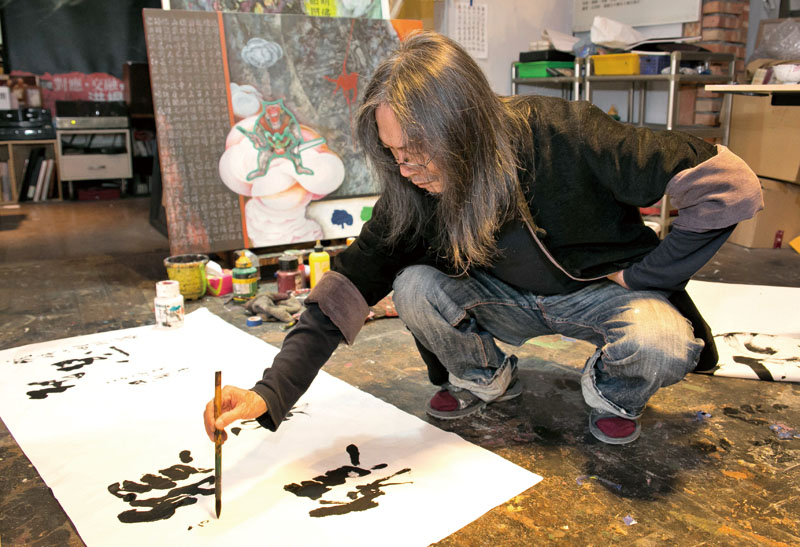Master of Ink and Brushes –Painter Hung Ken-shen/水墨畫家洪根深
Master of Ink and Brushes –Painter Hung Ken-shen
◎English translation: Peng Hsin-yi
◎Photo by Huang Ching-wen
 Ink painter Mr. Hung Ken-shen has long hair, appears somewhat detached, and issues strong personal statements. But once he opens up, you warm to him immediately.
Ink painter Mr. Hung Ken-shen has long hair, appears somewhat detached, and issues strong personal statements. But once he opens up, you warm to him immediately.
Now 68 years old, Mr. Hung is one of the most respected contemporary Taiwanese ink painters. Breaking away from the framework of modern Chinese ink painting, he launched what has become known as "Taiwanese Post-modern Ink Painting." It has become a school in its own right, and is seen as a pivotal point in the history of art in Taiwan. Mr. Hung was born and raised in Penghu, an archipelago located near Taiwan's southwest coast. He moved to Kaohsiung in 1972, and has been living and working there ever since. In Mr. Hung's eyes, the municipality's unique urban characteristics make it a nursery for distinctive art and culture, and it has become his inspiration. In Kaohsiung, his creativity put down roots, flourished and blossomed.
Mr. Hung says that being a true artist means keeping up with times. It is therefore important for an artist to keenly observe the world and continue to evolve. He is no fan of the idea of sticking to one method of painting for a lifetime, adding that the transformation of one's painting style is a never-ending work in progress, not an overnight transformation. Looking at works from different phases of his career, one gets distinctively different impressions, yet each style is meaningful and enriching in its own right.
For Mr. Hung, ink painting is part of his identity, a familiar element from his childhood. He can remember watching his grandfather and father writing with ink and brush pens. He studied in the Department of Fine Art, National Taiwan Normal University, and started to focus on landscape images created with ink after graduation. His signature style, the so-called "dry landscape" was developed during this period. Between 1977 and 1979, his dry landscapes reached maturity. With the deliberate play of brush strokes and different shades of ink, he was able to present natural scenes such as rocks, trees, as well as time and weather elements such as dawn and rain. His unique brush technique created a dry sense of beauty; hence he called his works "dry landscapes." Other than black ink, he also uses highly saturated colors such as orange, blue and yellow. He does not limit himself to brush pens; employing layers of sprayed paint, dyes, prints and rubbings give his paintings extra depth.
As an artist, Mr. Hung has demonstrated impressive creativity. In the 1980s, he painted mostly portraits in ink. It was his way to express his feelings and impressions towards Taiwan as a land, and the people who live here. In 1981, Mr. Hung's father suffered a car accident, and the image of his father lying in bed with his entire body wrapped in bandages has haunted him ever since. In 1983, Mr. Hung created a long horizontal scroll using acrylic paint and ink featuring human-shaped figures wrapped in bandages. This piece is called Modern Times, Human Nature, Human Life, and was the first time Mr. Hung had painted human figures as a vessel of expression. That was the beginning of his bandaged-figures era, with dry and heavy colors and textures, its signature style derived from liberal use of acrylic paint. In 1989, these dark images featuring bandaged figures were recognized as his "Black Sentiment" period, or Kaohsiung's "Black school of painting." Through his expert use of black, he started an open conversation with his audience about the anxieties that plague industrial cities across Taiwan as society marches forward and modernizes, while facing a suffocating atmosphere and the darkness within human nature.
Of the numerous pieces Mr. Hung has created, he is most happy with the "Humanity Series" and the "Black Sentiment" series. He says he painted those with feelings from the bottom of his heart, and they moved him so much more than everything else.
Already a leading figure in Taiwan's ink painting circles, Mr. Hung still feels the urge to paint and continually evolve, even after 44 years of creative work. His diligence is the fuel that drives "Taiwanese Post-modern Ink Painting" forward. But more than anything else, Mr. Hung inspires by showing how much he cares about this land and the people who lives here. In the splashes of black acrylic paint, one finds the rhythms of vibrant life forces that can move you.
水墨畫家洪根深
◎文/侯雅婷
◎攝影/黃敬文
畫家洪根深蓄著一頭性格長髮,予人些許距離感,但一開口,掩藏不住溫暖的特質。採訪這天,洪根深煮著曼特寧中烘培咖啡,咖啡香中談起他的創作和人生,餘韻十足。
現年68歲的洪根深是台灣當代最重要的水墨畫家之一,作品突破中國現代水墨藩籬,開創「台灣後現代水墨」畫風,自成一格的水墨作品大放異彩,作品在台灣美術史佔有一席之地。出生澎湖,1972年移居高雄,自此在新故鄉高雄創作。他眼中高雄的獨特城市性格孕育不同的文化,成為他想望的創作環境,他確信高雄一定能開創出與眾不同的高雄文化。
洪根深表示,作為一位藝術家要能與時俱進,培養敏銳的觀察力和堅持,自己不喜歡終其一生只用一種技法畫畫,但風格的轉換是漸進的轉化而非突變,觀察他每階段的轉化都精彩且寓意深遠。
水墨之於洪根深,始於兒時記憶裏,父親與爺爺振筆揮毫,對水墨的親切感油然而生。他自師範大學美術系畢業後,持續耕耘水墨風景畫,1977年至1979年,著名的「枯山水」水墨風格日趨成熟,結合山水的自然景致,岩石、樹木乃至於早晨、下雨等景致在他筆下呈現流溢的墨色和枯澀的美感,故名「枯山水」,除了墨色的運用,畫中還使用高彩度的橘紅、藍和黃,此外也運用噴、染、印、拓等技法,使畫面更豐富。
洪根深龐大的創作能量讓人驚豔,1980年代,洪根深大量創作水墨人物畫,表達台灣這片土地上的人物和情感;然而,洪根深父親1981年的一場車禍,全身裹著白色繃帶的畫面在他腦海中揮之不去,1983年,他以壓克力顏料和水墨畫出裹著繃帶的人形水墨長卷﹝現代‧人性‧生命﹞。這件作品被視為洪根深首次於人物畫的創作建立屬於自己的語彙,開啟一系列以繃帶人形為主軸的創作,由於壓克力彩的大量使用,畫面的質地和顏色都顯得乾澀沉重。1989年,鬱黑畫面裹著繃帶人形的系列畫作被稱為「黑色情節」風格,又被稱為「黑畫」。他藉由黑色情結裏深遂的黑,探討台灣現代化過程處於工業都市的焦灼、社會的苦悶以及人性的深沉。
在自己眾多的創作,洪根深最鍾情「人性系列」和「黑色情結」系列作品觸及他內心,感動也最深。
眼前這位台灣水墨畫壇巨擘始終孜孜不倦地埋首創作,44載如一日,不斷在作品中超越自己,成就「台灣後現代水墨」的一片璀璨,最讓人動容的是他對生長這片土地與人的關心,如同「黑畫」裏,濃厚的黑色壓克力顏料彰顯動人的生命力。